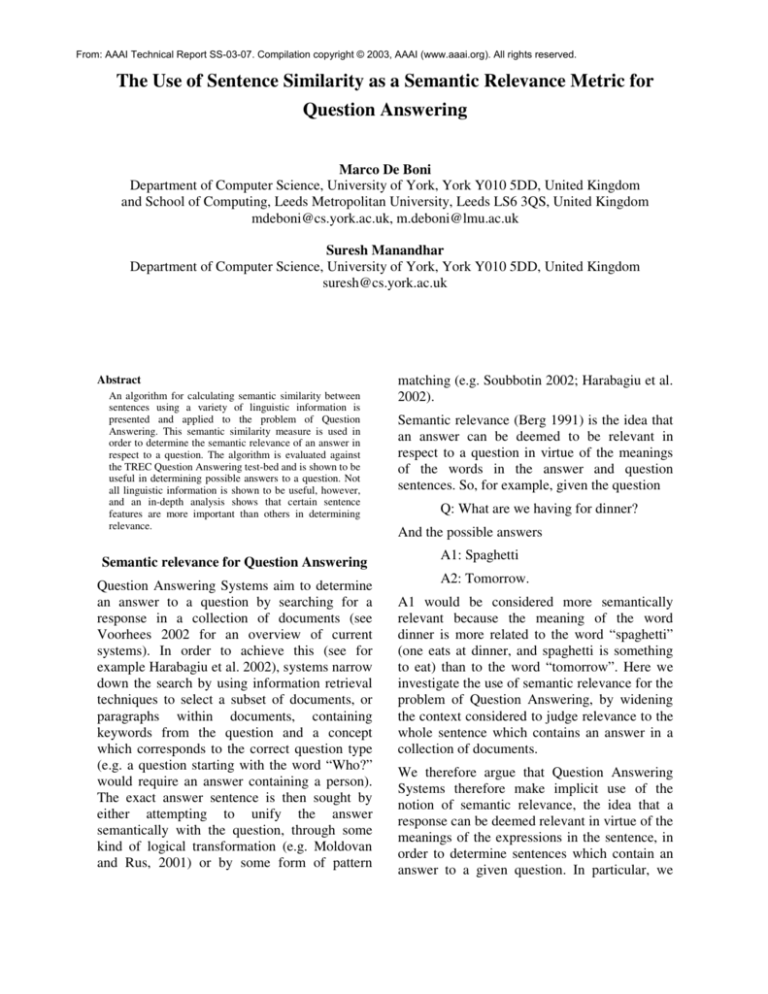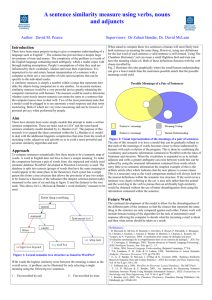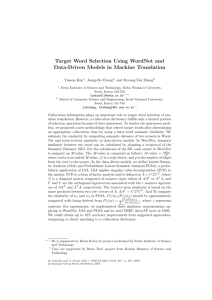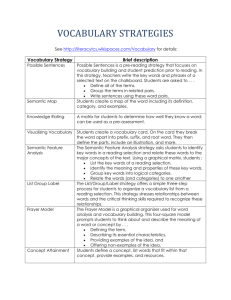
From: AAAI Technical Report SS-03-07. Compilation copyright © 2003, AAAI (www.aaai.org). All rights reserved.
The Use of Sentence Similarity as a Semantic Relevance Metric for
Question Answering
Marco De Boni
Department of Computer Science, University of York, York Y010 5DD, United Kingdom
and School of Computing, Leeds Metropolitan University, Leeds LS6 3QS, United Kingdom
mdeboni@cs.york.ac.uk, m.deboni@lmu.ac.uk
Suresh Manandhar
Department of Computer Science, University of York, York Y010 5DD, United Kingdom
suresh@cs.york.ac.uk
Abstract
An algorithm for calculating semantic similarity between
sentences using a variety of linguistic information is
presented and applied to the problem of Question
Answering. This semantic similarity measure is used in
order to determine the semantic relevance of an answer in
respect to a question. The algorithm is evaluated against
the TREC Question Answering test-bed and is shown to be
useful in determining possible answers to a question. Not
all linguistic information is shown to be useful, however,
and an in-depth analysis shows that certain sentence
features are more important than others in determining
relevance.
Semantic relevance for Question Answering
Question Answering Systems aim to determine
an answer to a question by searching for a
response in a collection of documents (see
Voorhees 2002 for an overview of current
systems). In order to achieve this (see for
example Harabagiu et al. 2002), systems narrow
down the search by using information retrieval
techniques to select a subset of documents, or
paragraphs within documents, containing
keywords from the question and a concept
which corresponds to the correct question type
(e.g. a question starting with the word “Who?”
would require an answer containing a person).
The exact answer sentence is then sought by
either attempting to unify the answer
semantically with the question, through some
kind of logical transformation (e.g. Moldovan
and Rus, 2001) or by some form of pattern
matching (e.g. Soubbotin 2002; Harabagiu et al.
2002).
Semantic relevance (Berg 1991) is the idea that
an answer can be deemed to be relevant in
respect to a question in virtue of the meanings
of the words in the answer and question
sentences. So, for example, given the question
Q: What are we having for dinner?
And the possible answers
A1: Spaghetti
A2: Tomorrow.
A1 would be considered more semantically
relevant because the meaning of the word
dinner is more related to the word “spaghetti”
(one eats at dinner, and spaghetti is something
to eat) than to the word “tomorrow”. Here we
investigate the use of semantic relevance for the
problem of Question Answering, by widening
the context considered to judge relevance to the
whole sentence which contains an answer in a
collection of documents.
We therefore argue that Question Answering
Systems therefore make implicit use of the
notion of semantic relevance, the idea that a
response can be deemed relevant in virtue of the
meanings of the expressions in the sentence, in
order to determine sentences which contain an
answer to a given question. In particular, we
propose a semantic relevance metric which does
not rely on logical inference or unification and
does not require the extensive work required for
handcrafted pattern matching rules and is
instead an extension of the idea of paragraph
similarity.
algorithm was employed to calculate the
semantic similarity between the question
sentence and the answer sentence. This was
then augmented to evaluate what additions
could improve the measure.
Basic Semantic Relevance Algorithm
Previous Work
To talk about semantic relevance is to talk about
the semantic similarity between sentences.
WordNet (Miller 1995; Fellbaum 1998), a
lexical database which organizes words into
synsets, sets of synonymous words, and
specifies a number of relationships such as
hypernym, synonym, meronym which can exist
between the synsets in the lexicon, has been
shown to be fruitful in the calculation of
semantic similarity. One approach has been to
determine similarity by calculating the length of
the path or relations connecting the words
which constitute sentences (see for example
Green 1997); different approaches have been
proposed (for an evaluation see Budanitsky and
Hirst 2001), either using all WordNet relations
(Hirst-St-Onge 1998) or only is-a relations
(Resnik 1995; Jiang-Conrath 1997; Lin 1998).
Mihalcea and Moldovan (1999), Harabagiu et
al. (1999) and De Boni and Manandhar (2002)
found WordNet glosses, considered as microcontexts, to be useful in determining conceptual
similarity. Lee et al. (2002) have applied
conceptual similarity to the Question
Answering task, giving an answer A a score
dependent on the number of matching terms in
A and the question.
Here we follow on these ideas, evaluating
different approaches to the measure of semantic
relevance for question answering, showing how
the use of WordNet information, part-of-speech
information and head-phrase chunking can
provide a reliable measurement for semantic
relevance.
A sentence similarity metric for Question
Answering
In order to determine the relevance of a possible
answer to a question, a basic semantic relevance
Semantic similarity was considered as a
function which took as arguments a question q
and an answer a and returned a value
representing the semantic relevance of a in
respect of q, i.e.
semantic-relevance( a, q ) = n ∈
The co-domain semantic-relevance( a, q) is
therefore made up of the real numbers ,
interpreted as: semantic-relevance(a1,q) <
semantic-relevance(a2,q) represents the fact that
answer a1 is less relevant than a2 in respect to
the question q and the context B.
In order to calculate the semantic similarity
between a question q and an answer q, q and a
were considered as sets A and Q of word stems.
The similarity between each word in the
question and each word in the answer was then
calculated and the sum of the closest matches
gave the overall similarity. In other words,
given two sets Q and A, where
Q={qw1,qw2,…,qwn} and
A={aw1,aw2,…,awm},
the similarity between Q and A is given by
∑1<p<n Argmaxm similarity( qwp, awm)
The function similarity( w1, w2) maps the stems
of the two words w1 and w2 to a similarity
measure m representing how semantically
related the two words are. The co-domain
similarity( w1, w2)is made up of the real
numbers
in the interval 0..1; similarity( wi,
wj)< similarity( wi, wk) represents the fact that
the word wj is less semantically related than wk
in respect to the word wi. In particular
similarity=0 if two words are not at all
semantically related and similarity=1 if the
words are the same.
similarity( w1, w2) = h ∈
where
0≤h≤1
The similarity function is calculated as follows:
similarity( w1, w2) = 0 if w1∈ST ∨ w2∈ST
where ST is a set containing a number of stopwords (e.g. “the”, “a”, “to”) which are too
common to be able to be usefully employed to
estimate semantic similarity.
Else
similarity( w1, w2) = s
where s is calculated as follows: the words w1
and w2 are then compared using all the available
WordNet relationships (is-a, satellite, similar,
pertains, meronym, entails, etc.), with the
additional relationship, “same-as”, which
indicated that two words were identical. Each
relationship is given a weighting indicating how
related two words are, with a “same as”
relationship indicating the closest relationship,
followed by synonym relationships, hypernym,
hyponym, then satellite, meronym, pertains,
entails.
So, for example, given the question:
“Who went to the mountains yesterday?”
and the possible answer
“Fred walked to the big mountain and then to
mount Pleasant”
Q would be
{who, go, to, the, mountain, yesterday}
A would be
{Fred, walk, to, the, big, mountain, and, then,
to, mount, Pleasant}
In order to calculate similarity the algorithm
would consider each word in turn. “Who”
would be ignored as it is a common word and
hence part of the list of stop-words. “Go” would
be related to “walk” in a is-a relationship and
receive a score s1. “To” and “the” would be
found in the list of stop-words and ignored.
“Mountain” would be considered most similar
to “mountain” (same-as relationship) and
receive a score s2: “mount” would be in a
synonym relationship with “mountain” and give
a lower score, so it is ignored. “Yesterday”
would receive a score of 0 as there are no
semantically related words in Q. The similarity
measure of Q in respect to A would therefore be
given by s1 + s2.
Enhanced Algorithm
The basic algorithm was augmented to consider
the following information about sentences:
NP chunking. The intuition behind the use of
NP chunks to determine similarity is the fact
that the phrase “When did [the big bad wolf] eat
[red riding hood] ?” is more similar to “[the bad
wolf] ate [red riding hood] [who] carried [a pink
chicken]” than “[the wolf] who wore [a pink
riding hood] ate [the bad red chicken]”. Words
appearing in similar NPs in both question and
answer were therefore considered more relevant
than words that did not.
Part-of-Speech tagging. The intuition behind
the use of Part-of-Speech tagging is that this
should disambiguate the senses of the words
sufficiently to avoid gross errors in determining
similarity, for example when considering the
word relative in the two phrases “the facts
relative [adjective] to the issue” and “John
visited his relatives [noun]”.
Compound noun information. The motivation
behind is similar to the reason for using
chunking information, i.e. the fact that the word
“United” in “United States” should not be
considered similar to “United” as in
“Manchester United”. As opposed to when
using chunking information, however, when
using noun compound information, the
compound is considered a single word, as
opposed to a group of words: chunking and
compound noun information may therefore be
combined as in “[the [United States] official
team]”.
Proper noun information. The intuition behind
this is that titles (of books, films, etc.) should
not be confused with the “normal” use of the
same words: “blue lagoon” as in the sentence
“the film Blue Lagoon was rather strange”
should not be considered as similar to the same
words in the sentence “they swan in the blue
lagoon” as they are to the sentence “I enjoyed
Blue Lagoon when I was younger”.
Word frequency information. This is a step
beyond the use of stop-words, following the
intuition that the more a word is common the
less it is useful in determining similarity
between sentence. So, given the sentences
“metatheoretical reasoning is common in
philosophy” and “metatheoretical arguments are
common
in
philosophy”,
the
word
“metatheoretical” should be considered more
important in determining relevance than the
words “common”, “philosophy” and “is” as it is
much more rare and therefore less probably
found in irrelevant sentences.
Evaluation
Method
The semantic relevance measure was used to
rank answer sentences for a total of 200
questions randomly chosen from the test
questions used in the NIST TREC-10 Question
Answering track (Voorhees 2002). The answers
sentences were sought in the set of 50
documents also provided by NIST for each
questions, which consisted of newspaper
articles from the Los Angeles Times, the New
York Times, the Financial Times, AP newswire
and the San Jose Mercury; which should have
(but were not guaranteed to) contained an
answer to the questions. The documents were
manually checked in order to verify that an
answer was actually present in the texts and
questions for which no answer was given in the
documents were discarded (about 32% of the
questions did not have an answer in the given
set of documents). The sentences were then
ranked using the above the semantic relevance
algorithm and the first 15 answer sentences
were manually checked to establish at which
rank (if any) an answer sentence was found.
A correct answer sentence was strictly taken to
be a sentence which “justified” an answer, i.e.
from which an intelligent reader could infer an
answer without the use of any knowledge which
could be employed to derive an answer without
the need to consult the answer document. This
meant that in a number of instances sentences
which could have been deemed to contain an
answer were judged as non-answers as they did
not justify the answer. So, for example, given
the question “When was the first stamp issued”,
the sentence “A block of “penny black” postage
stamps, issued in 1840, were sold at auction
Tuesday for about $442,680, an auction house
said.” was not judged to contain an answer, as
the correct answer (1840) could not be inferred
from this sentence alone.
Results
A number of runs were carried out in order to
determine what features would best determine
relevance (results are summarised in Figure 1).
The features examined were:
•
NP bracketing. This could be either:
o Present in full (“chunked”)
o Absent (“dumb”)
o Naïve (see below for an
explanation)
• Part of Speech Tagging, which could be
either
o Present
o Absent
o Flexible
A series of experiments were then carried
out with “normal” part-of-speech tagging
but with the addition of the following
features:
•
•
Word frequency information
Proper noun and compound
information.
word
For each set of features the ranked answers
were examined manually to identify the exact
rank of sentence containing an answer. In line
with the type of evaluation carried out for the
TREC QA workshop (Voorhees 2002), the
mean reciprocal rank (MRR), i.e. the average
reciprocal of the rank at which the answer was
found, was then computed for the given results.
Rank
Basic algorithm with POS
chunked
Ans. 1 (%)
Ans. 1-5 (%)
MRR
Rank
Ans. 1-5 (%)
MRR
Naïve
chunked
"dumb"
Basic algorithm , flexible POS
Naïve
chunked
“dumb”
Naïve
18.4
28.6
24.5
14.3
24.5
16.3
28.6
24.5
51
55.1
55.1
55.1
53
51
57.1
53
49
0.436
0.505
0.465
0.433
0.52
0.43
0.519
0.347
0.496
Basic algorithm , with
POS and word
frequency
chunked
Ans. 1 (%)
"dumb"
Basic algorithm , no POS
“dumb”
24.5
Basic algorithm , with Simple
POS, word frequency, Word
compounding and
Match
proper noun
identification
chuncked “dumb”
20.4
28.6
24.5
30.7
51
53
53
57.1
18
37
0.434
0.451
0.481
0.484
0.2
Fig. 1
Compared to a simple word match, the semantic
relevance algorithm is a great improvement.
However the individual features contribute in
different measure to this result. Initial
experiments indicated that NP chunking did not
contribute to improving performance. It was
speculated that this was in large part due to the
POS tagger, which incorrectly tagged adjectives
and nouns in a number of occasions. In order to
verify this, experiments were carried out with
“flexible” tagging which allowed words to be
considered both as nouns and adjectives. With
this correction NP chunking gave the best
results. Another possible cause for the poor
results in NP chunking was incorrect chunking.
In order to verify this, experiments were carried
out using a simple NP chunker that gathered
together words found between articles and
verbs. This gave better results when using the
standard POS tagging, but worse results in all
other cases, indicating that the given NP
chunker was indeed better that a simpler
chunker. Further analysis of the questions
indicated that the reason NP chunking did not
prove as useful as initially hoped was the type
of questions given, which were usually very
short, sometimes with NPs consisting of no
more than one word.
The addition of information about Proper nouns
(taken to be words beginning with a capital
letter), compound nouns (taken to be
compounds identified by WordNet, e.g. “United
States”) significantly improved performance. It
is important to note that recognising compound
nouns gave different information from the
recognition of NP chunks: a simple example is
the NP “the Coca Cola company” where the
compound noun was taken to be simply “Coca
Cola”.
Experiments were also carried out on the use of
word frequency information. Given that the
questions examined were generic queries which
did not necessarily refer to a specific set of
documents, the word frequency for individual
words was taken to be the word frequency given
in the British National Corpus (see BNCFreq
2002 for a list of the most frequent 3000 words
in English according to the British National
Corpus). The top 100 words (see BNCFreq
2002), making up 43% of the English
Language, were then used as stop-words and
were not used in calculating semantic similarity.
The similarity between words was therefore
weighted to take into account the commonality
of the words in generic English. This approach
also gave good results. A question answering
system tailored for a specific task, would
however have to use a word frequency table
specific to that task: “analgesic” may be an
infrequent term in everyday usage, but is quite
common in medical documents. While word
frequency improved the accuracy of the
mesurement not employing NP chunking, this
approach had a detrimental effect when
combined with NP chunking, probably due to
the fact that “chunks” containing very common
words were not able to furnish any useful
information gain.
Finally, the addition of information about
compound words (e.g. “compound interest”)
and information about which words proper
nouns provided the best results.
Discussion
When looking for a definite answer, semantic
relevance appears to be helpful: the best results
indicated that a sentence containing an answer
would ranked as the top answer sentence in the
document collection in 30.7% of cases. An
answer sentence would be ranked amongst the
top five most relevant sentences in 57.1% of
cases. In most of the remaining cases (around
90%) an answer was found in the top fifteen
sentences considered relevant, but the ranking
could not be correct due to very short questions
(e.g. “Where is Perth?”): indeed, in a number of
cases all sentences were assigned the same
similarity score. In other cases the answer
sentence required additional background
knowledge that was not provided by WordNet:
examples which caused answers to be missed
are the lack of any connection between the
words “midway” and “middle” and the very
tenuous connection between “man made object”
and satellite, which requires an elaborate
traversal of a number of different semantic
relations. In other cases some form of nontrivial reasoning would have been necessary to
deduce an answer: for example, there was no
answer in the set of documents to the question
“During which season do most thunderstorms
occur?”, but an intelligent reader could have
counted the number of times thunderstorms
were mentioned in articles about the weather
and deduced a statistical analysis of the
occurrence of thunderstorms during the year.
Yet more questions required assumptions about
questioners’ intentions, e.g. the question “What
is Wimbledon?”, which could have had as
answer “A part of London”, or “A tennis
competition”.
To get an idea of the performance that a system
which used this algorithm could achieve, the
best system at the TREC 2002 QA workshop
(Soubbotin 2002), which employed a very rich
and complex system of pattern matching, found
an answer in the top 5 sentences 69.1% of the
time, with a MRR of 0.676; the top five systems
had an average MRR of 0.518 and an answer in
the top five sentences on average 62.1% of the
time. Simply using documents provided by a
standard Information Retrieval engine, the
semantic relevance algorithm presented
correctly ranked the sentence containing an
answer in the top 5 sentences 57.1% of the time,
with a MRR of 0.519. Combining this semantic
relevance algorithm with the techniques used by
the TREC participants (complex pattern
matching, precise question-type and namedentity recognition, simple forms of logical
inference or abduction) could therefore give
some very positive results.
Conclusions and Further work
Semantic relevance therefore does provide a
useful indication to which sentences in a
document collection contain the answer to a
question. On its own, however, this metric
cannot provide an answer in all cases and other
techniques such as the additional of domainspecific knowledge, logical inference and
information about user goals must be used to
determine the actual answer in the remaining
cases. Future work will examine the integration
of the given semantic relevance metric with
additional background knowledge and the use
of inferencing and knowledge about user goals
to deduct answers.
Bibliography
BNCFreq. 2002. (last accessed June 2002).
http://www.eecs.umich.edu/~qstout/586/bncfreq.html.
Budanitsky, A., and Hirst, G. 2001. “Semantic distance in
WordNet: and experimental, application-oriented
evaluation of five measures”, in Proceedings of the
NAACL 2001 Workshop on WordNet and other
lexical resources, Pittsburgh.
De Boni, M. and Manandhar, S., 2002. “Automated
Discovery of Telic Relations for WordNet”,
Proceedings of the First International WordNet
Conference, India.
Fellbaum, C., 1998. “WordNet, An electronic Lexical
Database”, MIT Press.
Green, S. J., 1997. “Automatically generating hypertext
by computing semantic similarity”, Technical Report
n. 366, University of Toronto.
Harabagiu, S. A., Miller, A. G., Moldovan, D. I., 1999.
“WordNet2 - a morphologically and semantically
enhanced resource”, In Proceedings of SIGLEX-99,
University of Maryland.
Harabagiu, S., et al., 2002. “Answering Complex, List
and Context Questions with LCC’s QuestionAnswering Server”, Proceedings of TREC-10, NIST.
Hirst, G., and St-Onge, D. 1998. “Lexical chains as
representations of context for the detection and
correction of malapropisms”, in Fellbaum (ed.),
“WordNet: and electronic lexical database”, MIT
Press.
Jiang, J. J., and Conrath, D. W. 1997. “Semantic
similarity based on corpus statistics and lexical
taxonomy”, in Proceedings of ICRCL, Taiwan.
Lee, G. G., et al., 2002. “SiteQ: Engineering High
Performance QA System Using Lexico-Semantic
Pattern Matching and Shallow NLP”, Proceedings of
TREC-10, NIST,
Lin, D., 1998. “An information-theoretic definition of
similarity”, in Proceedings of the 15th International
Conference on Machine Learning, Madison.
Mihalcea, R. and Moldovan, D. 1999. “A Method for
Word Sense Disambiguation of Unrestricted Text”, in
Proceedings of ACL ‘99, Maryland, NY.
Miller, G. A. 1999. “WordNet: A Lexical Database”,
Communications of the ACM, 38 (11).
Moldovan, D. and Rus, V. 2001. “Logic Form
Transformation of WordNet and its Applicability to
Question Answering”, Proceedings of the 39th
conference of ACL, Toulouse.
Resnik, P. 1995. “Using information content to evaluate
semantic similarity”, in Proceedings of the 14th IJCAI,
Montreal.
Soubbotin, M.M., 2002. “Patterns of Potential Answer
Expressions as Clues to the Right Answers”,
Proceedings of TREC-10, NIST.
Voorhees, E. 2002. “Overview of the TREC 2001
Question Answering Track”, Proceedings of TREC-10,
NIST.









